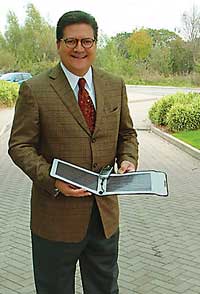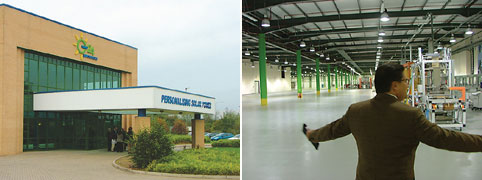

eed to charge your mobile phone in Kenya? G24i‘s dye-sensitized thin film solar technology aims to help you do just that. And where might such a firm, born in the solar-awareness capital of California, choose to locate its new global headquarters, manufacturing and R&D complex? The sunny clime of Cardiff, Wales.
Bob Hertzberg, chairman of G24i, knows how to navigate the shoals of politics, having served in the California General Assembly beginning in 1986, served as Speaker of that body from 2000 to 2002 and run a close race for mayor of Los Angeles in 2005. He’s been involved in environmental policy issues for many years, but that didn’t make it easier when he, partner Ed Stevenson and a third partner tried to get a solar technology company started there.
“We ran into a buzz saw in L.A,” he said in a recent interview on company grounds in Wales, during his 38th visit to the country in 18 months.

“Despite all the noise, there is a huge gulf there between ‘being green’ and actually letting you be green. It took me nine months to get power from the municipal agency. There is no depth or dimension at any level. Pricing and a bunch of reasons were running in the face of being green, and we were angry about the backwardness.”
So they decided to go to market in the U.K., where European receptivity to renewable energy is reflected in a knowledgeable financial community and a regulatory framework exactly one ocean away from Sarbanes-Oxley, which Hertzberg says “makes it almost impossible to go to market in the U.S.”
After the mayoral loss, Stevenson sold his interest in a former solar company in favor of searching for a technology that wasn’t silicon based. “Traditional silicon is like the car engine,” says Hertzberg of an industry he thought was in need of a kick in the pants. “Nothing has changed in 50 years.”
In addition, the capital costs involved with silicon are tremendous, says Hertzberg. So, too, are the costs to the environment, when considering the energy required to extract silicon from sand.
So the investors turned to a model based on technology that mimicked plant photosynthesis. The dye-sensitized solar cell on flexible material coated with titanium dioxide is the result.
While the technology was generally thought not to be commercializable until 2011-2012, Hertzberg and crew were ready to get going now. So they’re investing US$119 million and hiring up to 300 people at their sole complex in Cardiff. The first production line will produce 30 MW of solar material in 2008, with a target of 200 MW by 2009.
“It takes entrepreneurs able to jump off a cliff,” says Hertzberg. “Big companies are generally run by middle managers scared to death by their own shadows. Venture capitalists only will do it if they own 99.8 percent of the company and enslave you. We found this, spent a lot of money doing due diligence, and think that if you build it, they will come.”
Where they built it is on 23 acres (9.3 hectares) in an industrial area on the outskirts of the Welsh capital.
“It was clear we wanted to locate in Europe, in or near London,” says Hertzberg. The search included places such as Birmingham and Ireland, within relatively easy reach of London markets. Being “truly green” was a criterion too.
“We were looking for a place that met our philosophical points of view about what we wanted to do with the company,” he says. “We believe renewable companies have to have as close to a zero carbon footprint as possible.”
One element helping achieve that is a planned 2.5-MW wind turbine on the campus grounds. “Wind energy will help create solar energy,” says Hertzberg, preparing to host Cardiff Council officials to review the turbine plans. “The locals have been phenomenal with respect to speed and implementing – everyone has green plans, but implementation requires balancing interests.”
Other criteria included a campus setting, and the desire to integrate company activities with the community’s. Hence the environmental learning center – conceived with officials from Cardiff and from Cardiff University – that will inhabit the front half of the building. There is a tax benefit associated with the establishment of the not-for-profit center. In December, the company also signed an R&D agreement with the university’s Center for Energy, Waste and the Environment at Cardiff School of Engineering.
Hertzberg thinks the G24i center is an important way for the company to live its slogan, by bringing renewable energy – thought by most to be only an indulgence for those who can afford it – to a personal level, just as G24i’s product brings it to an affordable level.
The target market for the product is the large population that has very little power grid access.

“They can afford a cell phone, but don’t have access to power,” he says, noting that mobile phone companies charge by the second instead of the minute for that very reason. Affixing G24i’s product to backpacks, then, allows for constant recharging, and with a rugged product that has a much longer lifetime (10 years is the goal) than batteries. The charging units are being sold to phone companies for approximately $25 apiece.
“Why use disposable batteries if you could recharge while walking along?” Hertzberg asks. Developing-world mobile phone users number approximately 600 million, but are expected to blossom to 2 billion by 2015.
The core building at the Wentloog site formerly belonged to Taiwanese computer company Acer, whose original three-site plans were upended by the high-tech downturn. As a consequence, the building sat vacant for eight years.
“I had a conversation with Helen [Donovan, project manager with International Business Wales],” says Hertzberg. “We only started a year and a half ago, and went at breakneck speed. I said, ‘Meet our terms and I’ll show up, but don’t waste my time.’ They met the terms.”
While incentives were offered, none were taken: proof that speed to market truly was of utmost importance. Hertzberg has a similar disdain for government subsidies for environmentally friendly technologies.
“I was very involved with creating renewable portfolio standards and subsidies,” he says. “We have to get off subsidies. They are not respected by markets. Frankly, we wanted a green business that could stand on its own two feet … with a few quid for the fence outside.”
Hertzberg says the site decision was reached very quickly, arriving from the States at 9 a.m., meeting with Welsh Assembly Government First Minister Rhodri Morgan and Minister for Economic Development and Transport Andrew Davies by noon,
“and at three in the afternoon I was going back to the U.S. I asked if we could do a deal by December 1 [2006]. And they did.”
The company has invested $10 million in the facility, $1 million for the floor alone in the 187,000-sq.-ft. (17,372-sq.-m.) space. Another $25 million had gone into machinery as of fall 2007, with more machines on the way. Even with the machines, says Hertzberg, speed was of the essence: “They said 18 months, and we said six months,” he says of his negotiations with the vendors.
Hertzberg says only two percent of the market is on flexible material (the rest is on glass), and most of the competition is either too expensive or too weak in power production. Moreover, the flexibility of the product means a flexible “roll-to-roll” manufacturing process, which Hertzberg says is more like papermaking than the batch process associated with most solar panel products. This allows the product to be made in 800-m., 100-lb. rolls, and therefore allows energy expenditure to be affordably spread over a large number of modules.
“We can produce as much as we can possibly produce here in Cardiff,” he says. “There’s no need to go all over the world, because this is technology driven. Asia does not give us huge market advantages. This place is big enough. Put this in a FedEx envelope and ship it. There’s no need to build 20 of these facilities.”
The complex is designed, says Hertzberg, to “do as much on site as we can,” with a commissary serving company-purchased meals, and a machine shop.
“It’s a good brainstorming environment,” says Herzberg. “Patents emanate from here.” G24i had filed or applied for 37 patents in the year ending in October 2007, both in the U.K. and abroad.
Hertzberg stresses that “there are no unskilled workers here.” There also are no outside investors. “The biggest shareholders are our wives,” he quips. “We have skin in the game. Now it’s showtime.”
This past fall, the company was filling its first order for mobile phone use in Africa, with approximately 35 employees and more on the way. But still … why Wales?
“It works in the rain,” he says of the firm’s product. “We think our strategic advantage with respect to this product line is the stuff has the ability to work in lower-light conditions. This makes solar available to whole different parts of the world.”
Site Selection Online – The magazine of Corporate Real Estate Strategy and Area Economic Development.
©2008 Conway Data, Inc. All rights reserved. SiteNet data is from many sources and not warranted to be accurate or current.